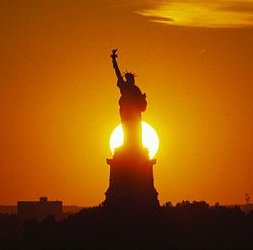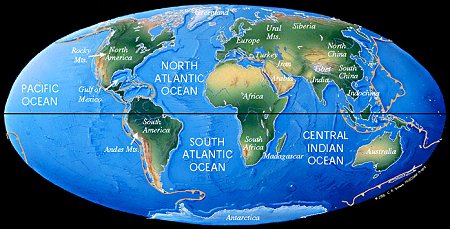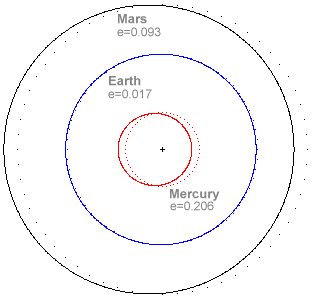|
Earth at Perihelion You learned it in school; astronomers say it all the time; it's The Truth. "Earth circles the Sun." Well... almost. Earth does travel around the Sun, but the path is not a perfect circle. It's an ellipse, slightly lopsided. One end is a bit closer to the Sun than the other.
"All planets in our solar system travel around the Sun in elliptical orbits. It's Kepler's 1st Law," says University of Florida astronomy professor George Lebo. "The eccentricity of Earth's orbit is 1.7%. In January when we're closest to the Sun (perihelion), the distance is 147.5 million km vs. 152.6 million km in July--the farthest point (aphelion)." A nearby sun means more sunlight for our planet. "Averaged over the globe, sunlight falling on Earth at perihelion is about 7% more intense than it is at aphelion," says Roy Spencer of NASA's Global Hydrology and Climate Center (GHCC). Then why is it so cold outside? "Seasonal weather patterns are shaped primarily by the 23.5 degree tilt of our planet's spin axis, not by aphelion or perihelion," explains Lebo. "During northern winter the north pole is tilted away from Sun. The Sun hangs low in the sky, and days are short. That's what makes January so cold." (Note: Seasons are reversed in the two hemispheres, north and south. So January is generally warm in the south.) There's more to the story: Says Spencer, "the average temperature of the whole earth at perihelion is about 4oF or 2.3oC lower than it is at aphelion." (See the global temperature data at the GHCC web site.) Our planet is actually colder when we're closer to the Sun. Strange but true. Above: Earth's land-masses are found more north of the equator than south. But it wasn't always that way. Image credit and copyright: the PALEOMAP Project. This happens because continents and oceans aren't distributed evenly around the globe. There's more land in the northern hemisphere and more water in the south. During the month of July the land-crowded northern half of our planet is tilted toward the Sun. "Earth's temperature is slightly higher in July because the Sun is shining down on all that land, which heats up rather easily," says Spencer. Physicists would say that continents have low heat capacity. "Consider the desert," says Bill Patzert, an oceanographer at NASA's Jet Propulsion Laboratory. "At night the desert is cold, perhaps only 60o F (16o C). When the Sun rises in the morning the temperature might jump to 100o F (38o C) or more." Such mercurial behavior is characteristic of materials like rocks and soil with low heat capacity. It doesn't take much sunlight to substantially elevate their temperature. Water is different. It has high heat capacity. "Let's say you went sailing off Malibu Beach at noon," continues Patzert. "The offshore temperature might be 75o F (24o C) -- pretty pleasant!" What happens after sunset? "The temperature drops, but only a few degrees because the heat capacity of the ocean is so high." All this explains why July is our planet's warmest month: Northern continents baked by the aphelion Sun elevate the average temperature of the entire globe. January, on the other hand, is the coolest month because that's when our planet presents its water-dominated hemisphere to the Sun. "We're closer to the Sun in January," says Spencer, "but the extra sunlight gets spread throughout the oceans." Southern summer in January (perihelion) is therefore cooler than northern summer in July (aphelion).
"Another notable difference between summers in the two hemispheres is their duration," adds Lebo. According to Kepler's 2nd Law, planets move more slowly at aphelion than they do at perihelion. As a result, Northern summer on Earth is 2 to 3 days longer than southern summer -- which gives the Sun even more time to bake the northern continents. Author: Dr. Tony Phillips Web Links: Earth's Seasons -- (US Naval Observatory) dates and times of equinoxes, solstices, perihelia, and aphelia Daily Earth Temperatures from Satellites -View global atmospheric temperature trends at different layers of the atmosphere, courtesy of the Global Hydrology and Climate Center. Kepler's Laws: animated (by physics teacher Bill Drennon); a mathematical introduction (NASA/GSFC) Shaq's Solstice Shadows -- (Science@NASA) Shaquille O'Neal's stubby shadow is proof that our planet is tipped on its side--and summer has arrived Seasons: The Movie -- (NASAKids.com) a too-cool movie explaining the seasons. |
 On
January 4th, 2006, our planet is at the closer end--a point astronomers
call "perihelion." We'll be closer to the Sun than we are
at any other time of the year.
On
January 4th, 2006, our planet is at the closer end--a point astronomers
call "perihelion." We'll be closer to the Sun than we are
at any other time of the year.
 Right:
Earth's orbit is eccentric but not nearly so much as the orbits of Mars
or Mercury. In this diagram solid lines trace each planet's elliptical
path around the Sun. The dotted lines show circular orbits with the
same mean radius. For more information, please visit Bridgewater College's
Right:
Earth's orbit is eccentric but not nearly so much as the orbits of Mars
or Mercury. In this diagram solid lines trace each planet's elliptical
path around the Sun. The dotted lines show circular orbits with the
same mean radius. For more information, please visit Bridgewater College's